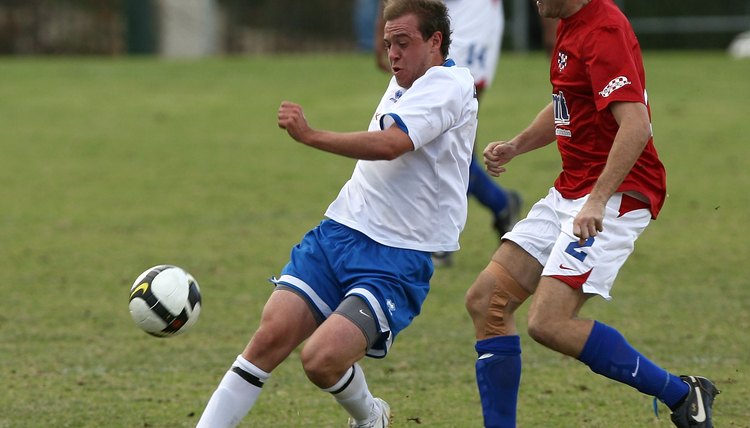What does fact checked mean?
At SportsRec, we strive to deliver objective content that is accurate and up-to-date. Our team periodically reviews articles in order to ensure content quality. The sources cited below consist of evidence from peer-reviewed journals, prominent medical organizations, academic associations, and government data.
- Journal of Sports Sciences; The Changing Shape of "Successful" Professional Footballers; A. Nevill, et al.
- Journal of Sports Sciences; The Changing Shape of "Successful" Professional Footballers; A. Nevill, et al.
- Journal of Strength and Conditioning Research; Fitness Profiling in Soccer: Physical and Physiologic Characteristics of Elite Players; G. Sporis, et al.
- Journal of Strength and Conditioning Research; Fitness Profiling in Soccer: Physical and Physiologic Characteristics of Elite Players; G. Sporis, et al.
The information contained on this site is for informational purposes only, and should not be used as a substitute for the advice of a professional health care provider. Please check with the appropriate physician regarding health questions and concerns. Although we strive to deliver accurate and up-to-date information, no guarantee to that effect is made.
The Ideal Weight for a Soccer Player

Soccer players at the recreational level come in all shapes and sizes. At the higher levels of the game, though, players tend to have a very fit physique, lean and muscular without being too skinny or overly muscled. Professional male forwards -- and the occasional female, such as former U.S. women's player Brandi Chastain -- don’t hesitate to whip off their shirts after scoring, often displaying perfect six-pack abs and a noticeable lack of flab.
Soccer Players' BMI
More than nine out of 10 elite soccer players have a body mass index that falls in the normal range, according to a survey of players in the 2006 FIFA Men’s World Cup. Eddison Cantor and Jeff G. Konin of the University of South Florida’s Athletic Training Education Program ran the numbers for the 736 players from 32 teams. They found that 92 percent of the players fell in the body mass index range rated normal, between 20 and 24.9 -- in practical terms, normal BMI coincides with ideal weight. The normal weight range for a player 5 feet 9 inches tall is 136 to 169 pounds.
BMI Range by Position
The World Cup player survey also found 1 percent of the players were underweight, 6 percent overweight and 1 percent obese. When surveyed by position, goalkeepers fell into the normal range 85 percent of the time, with 14 percent overweight. In contrast, defenders were in the 93 percent normal range with 6 percent overweight; midfielders 94 percent normal with 5 percent overweight, and forwards, 92 percent normal with 5 percent overweight. The authors recommended continued research comparing BMI to performance and to identify BMI numbers for female professional players.
World Cup vs. Major League vs. College Players
Konin and his USF colleagues broadened their studies to compare the World Cup participants with players in Major League Soccer, the top U.S. professional league, and college players in the Big East Conference. Averages for players at all levels -- college, professional and international -- landed between 23 and 24 BMI, with the exception of MLS goalies, who averaged 25.2.
Significance of Weight
Football coaches and talent scouts look for key characteristics that bode well for success at the highest levels of soccer, says Alan Nevill and his colleagues at the University of Wolverhampton. Nevill found that professional soccer players from the top six teams in England were taller and leaner than those from less successful teams. Weight also may predict greater success for soccer athletes at specific positions, since goalkeepers and defenders are typically heavier than midfielders and forwards.
Soccer and Body Fat
More important than BMI for the typical recreational player is percent of body fat, note the former soccer pros at Expert Football. Excess body weight limits your mobility in a game where starting players typically need to stride, jog, run and sprint for 5 to 7 miles during each match. A study in 2004 of nearly 700 boys aged 9 to 14 years old by Luis A. Moreno and colleagues in Zaragoza, Spain, found that the percentage of body fat was significantly lower among the boys who played soccer, likely indicating that playing soccer melts off extra pounds.
References
- University of South Florida: Body Mass Index for FIFA World Cup Professional Soccer Players
- University of South Florida: Comparison of BMI Between University and Professional Soccer Players
- Journal of Sports Sciences; The Changing Shape of "Successful" Professional Footballers; A. Nevill, et al.
- Journal of Strength and Conditioning Research; Fitness Profiling in Soccer: Physical and Physiologic Characteristics of Elite Players; G. Sporis, et al.
Writer Bio
An award-winning writer and editor, Rogue Parrish has worked at the Washington Post, the Baltimore Sun and at newspapers from England to Alaska. This world adventurer and travel book author, who graduates summa cum laude in journalism from the University of Maryland, specializes in travel and food -- as well as sports and fitness. She's also a property manager and writes on DIY projects.
